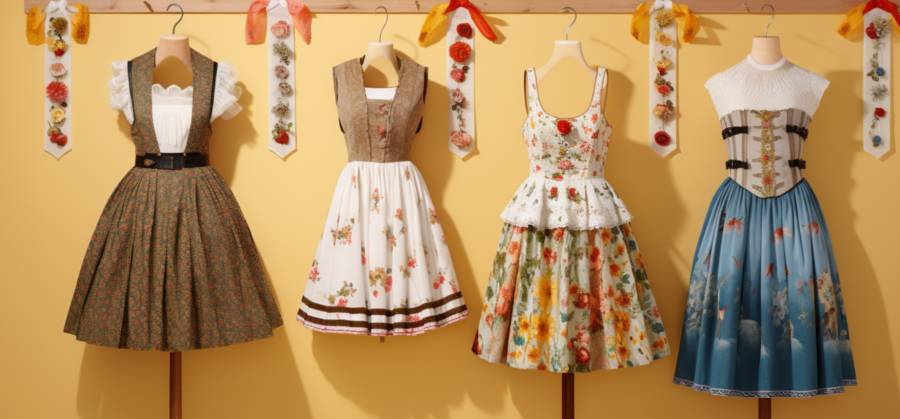Dirndl and Lederhosen: Bavarian Folk Costume Charm

A Brief History of Bavarian Folk Costumes
Long ago, in a land far, far away (well, not that far away if you're in Europe), the people of Bavaria decided that they needed some stylish threads to showcase their cultural pride. The Dirndl and Lederhosen were born - garments that would come to symbolize a unique blend of tradition, fashion, and practicality. Like a well-aged pretzel, the charm of these costumes has only grown over time, as they continue to be an essential part of Bavaria's cultural fabric.Lederhosen: More Than Just Leather Shorts
When you think of Lederhosen, you might imagine a group of jolly Bavarian men at a beer garden, hoisting steins of frothy brew and rocking some seriously impressive facial hair. While this vision isn't entirely inaccurate, there's more to these distinctive leather breeches than meets the eye.Traditionally worn by working-class men in the Alpine regions of Bavaria, Lederhosen were designed to be durable and comfortable - after all, you don't want a wardrobe malfunction while you're herding goats in the mountains. Made from tanned deer or goat leather, these shorts (or knee-length breeches for the more conservative gentleman) are typically adorned with intricate embroidery, representing the wearer's region or town.
While you may be tempted to don some Lederhosen and blend in with the locals, be forewarned: it's not all fun and games when it comes to these breeches. There's an unspoken hierarchy when it comes to Lederhosen etiquette, with longer, more ornate designs signifying higher social status. So before you strut your stuff in a pair of these bad boys, make sure you're not unintentionally stepping on any toes (or beards).
Dirndl: The Original Power Dress
If you're not familiar with the Dirndl, picture this: a tightly-laced bodice, a full skirt, and an apron, all in vibrant colors and eye-catching patterns. This traditional Bavarian dress was once the uniform of housemaids and peasants, but it has since evolved into a versatile ensemble that can be dressed up or down for any occasion.The key to rocking a Dirndl like a true Bavarian is all in the details. Start with a crisp, white blouse (preferably with puffed sleeves, because who doesn't love a little drama?), and don't forget the all-important apron. The apron knot is where things get really interesting - how you tie it sends a subtle message about your marital status. A knot on the left means you're single and ready to mingle, while a knot on the right signifies that your heart is spoken for. A knot in the center means you're a virgin, and a knot in the back means you're either widowed or a waitress. Don't say we didn't warn you about the power of the Dirndl!
Modern Interpretations and Fashion-Forward Folk Costumes
Like any enduring fashion trend, the Dirndl and Lederhosen have seen their fair share of modern updates. While the classic silhouette remains largely unchanged, designers have taken creative liberties with fabrics, colors, and patterns to cater to a more contemporary crowd. From edgy, all-black ensembles to cheeky, pop-culture-inspired prints, there's a Bavarian folk costume for just about everyone.One thing that hasn't changed, however, is the unparalleled charm that comes with donning traditional Bavarian attire. Whether you're attending a beer festival, a wedding, or just want an excuse to sport some seriously unique threads, there's no denying the appeal of the Dirndl and Lederhosen. So why not embrace your inner Bavarian and give these timeless garments a try? You never know, you might just become the life of the (beer garden) party.
Where to Buy Dirndl and Lederhosen
So, you've decided you simply must have a Dirndl or Lederhosen in your wardrobe. Where do you find these fabulous garments, you ask? Fear not, for we have the answers.- First and foremost, when in Bavaria, do as the Bavarians do: head to a local Trachten (traditional clothing) shop. There, you'll find a wide selection of Dirndl and Lederhosen, ranging from affordable off-the-rack options to custom-made designs.
- If you're not in Bavaria, but still have a hankering for some folk costume fun, there are plenty of online retailers specializing in traditional German attire. Just make sure to double-check their sizing charts and read reviews to ensure you're getting a quality product.
- Finally, if you're on a budget or feeling particularly crafty, why not try your hand at making your own Dirndl or Lederhosen? There are plenty of sewing patterns and DIY tutorials available online to guide you through the process.
Article kindly provided by foreverinfashion.org
Latest Articles
- The Psychology of Tattoo Aesthetics: Why Certain Imagery Resonates
- Style That Works With Your Body, Not Against It
- Fashion Tourism on Wheels: Curated Shopping Routes Led by Chauffeur Guides
- The Charm of Certainty in a World of Indecision
- Can an Everyday T-Shirt Be Turned into a Modern Heirloom?
- Color, Ceremony, and the Psychology of Celebration
- Styling Graphic T-Shirts for Different Body Types
- Getting Kids to Wear Their Hats Without a Bribe or a Meltdown
- Mastering the Art of Being the Unnoticed Photographer
- Quiet Sportswear Moves Loudly
- Fashion's Most Misunderstood Color Is Brown
- Weight Matters When Cotton Gets Real
- SKU's Out for Summer: Why Your Warehouse Is Melting Down
- Ink as Accessory - How Tattoos Are Replacing Jewelry in Modern Style
- Accessories
- Jewellery
- Footwear
- Skirts and Dresses
- Shirts and Blouses
- Beauty and Makeup
- Fashion Photography
- Sustainable Fashion
- Street Style
- Fashion History
- Fashion Business
- Fashion Styling
- Fashion Events
- Plus-Size Fashion
- Men's Fashion
- Women's Fashion
- Fashion Blogging
- Fashion Trends
- Fashion Retailers
- Fashion Tips and Advice
- Fashion Business Startups
- Fashion Around the World
- Lingerie
- Sportswear
- Weddings

